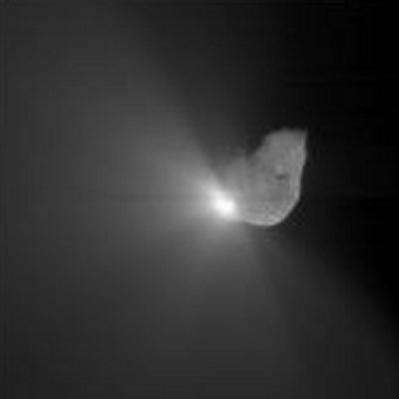Deep Impact 'celebrates' New Year's Eve with Earth flyby

Earth Flyby and Moon Pics Mark Start of Journey to Hartely 2
This New Year's Eve the University of Maryland-led Deep Impact team will again celebrate a holiday in a way that few can match, when their Deep Impact spacecraft "buzzes" the Earth on a flyby that marks the beginning of a more than two-and-a-half-year journey to comet Hartley 2.
In 2005, the Deep Impact team, led by University of Maryland astronomer Michael A'Hearn, celebrated July 4th by smashing a probe into comet Tempel 1 to give the world its first look inside a comet.
The trip to Hartley 2 is one part of a new two-part mission for the team and its Deep Impact spacecraft. During the first six months of the journey, the Extrasolar Planet Observations and Characterization (EPOCh) mission team will use the larger of the two telescopes on the Deep Impact spacecraft to search for Earth-sized planets around five stars selected as likely candidates for such planets. Upon arriving at the comet the Deep Impact eXtended Investigation (DIXI) will conduct an extended flyby of Hartley 2 using all three of the spacecraft's instruments (two telescopes with digital color cameras and an infrared spectrometer. The name for the new combined mission, EPOXI, is a combination of the names of its component missions (EPOCh + DIXI = EPOXI).
The team is using the flyby of Earth to calibrate the spacecrafts instruments for the new mission and to help slingshot it on the way toward Hartley 2. Although the spacecraft will come closest to the Earth on New Year's Eve, the Maryland-led team has already begun its calibration work.
"On Saturday, 29 December, two days before its close flyby of Earth, the Deep Impact flyby spacecraft made observations of the moon to calibrate its instruments for its new mission, EPOXI," said A'Hearn. "Some calibrations are obtainable only on a bright, large source, like the moon when reasonably close to it. It looks as though everything operated just as the science team asked it to operate and you can't ask for anything better than that,- he said. "
'This Earth gravity assist provided a unique opportunity for us to calibrate our instruments using the Moon," said Jessica Sunshine, a senior research scientist at the University of Maryland. "In particular, the Moon is very useful because it fills the entire field of view of the infrared spectrometer. The results show that our spacecraft pointing and commanding was spot on. We also made measurements which will allow us to cross-calibrate our instruments with telescopic data and, in the very near future, with a wealth of lunar measurements from new orbiting spacecraft. These data will significantly improve the science from EPOCh observations of Earth and the DIXI flyby of comet Hartley 2, as well as from Deep Impact's prime mission to comet Tempel 1," said Sunshine who is deputy principal investigator on DIXI.
Source: University of Maryland




















